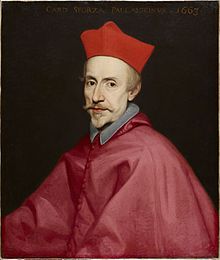Sforza Pallavicino | |
|---|---|
 Attributed to Giovanni Maria Morandi, Portrait of Cardinal Sforza Pallavicino, 1663 (oil on canvas, British embassy, Vatican City, Holy See) | |
| Diocese | Diocese of Rome |
| Appointed | 9 April 1657 |
| Term ended | 4 June 1667 |
| Orders | |
| Created cardinal | 9 April 1657 by Pope Alexander VII |
| Rank | Cardinal-Priest of San Salvatore in Lauro |
| Personal details | |
| Born | November 28, 1607 |
| Died | 4 June 1667 (aged 59) Rome |
| Buried | Sant'Andrea al Quirinale |
| Denomination | Roman Catholic |
| Parents | Alessandro Pallavicino Francesca Sforza di Santa Fiora |
| Alma mater | Roman College Philosophy career |
| Education | Roman College (Ph.D., 1625; D.Th. 1628) |
| Era | Baroque philosophy |
| Region | |
| School | Aristotelianism Scholasticism Conceptualism |
| Institutions | Roman College |
| Doctoral advisor | Juan de Lugo |
| Notable students | |
Main interests | Natural philosophy, metaphysics, epistemology, aesthetics |
|
Preview warning: Page using Template:Infobox philosopher with unknown parameter "influences" Preview warning: Page using Template:Infobox philosopher with unknown parameter "influenced" | |
| Coat of arms | |
Francesco Maria Sforza Pallavicino or Pallavicini (28 November 1607 – 4 June 1667), was an Italian cardinal, philosopher, theologian, literary theorist, and church historian.
A professor of philosophy and theology at the Roman College and a fixture of important academies such as the Accademia dei Lincei and the Academy of Prince Maurice of Savoy, Pallavicino was the author of several highly influential philosophical and theological treatises (praised among others by Gottfried Wilhelm Leibniz, Benedetto Croce and Eugenio Garin) and of a well-known history of the Council of Trent that remained authoritative until the late 19th century.
- ^ B. Croce, Estetica (Bari, Laterza, 1922), pp. 253-4; Storia della età barocca in Italia (Bari, Laterza, 1929), p. 228; F. Nicolini, Fonti e riferimenti storici della seconda Scienza Nuova (Bari, Laterza, 1931), I, 94.